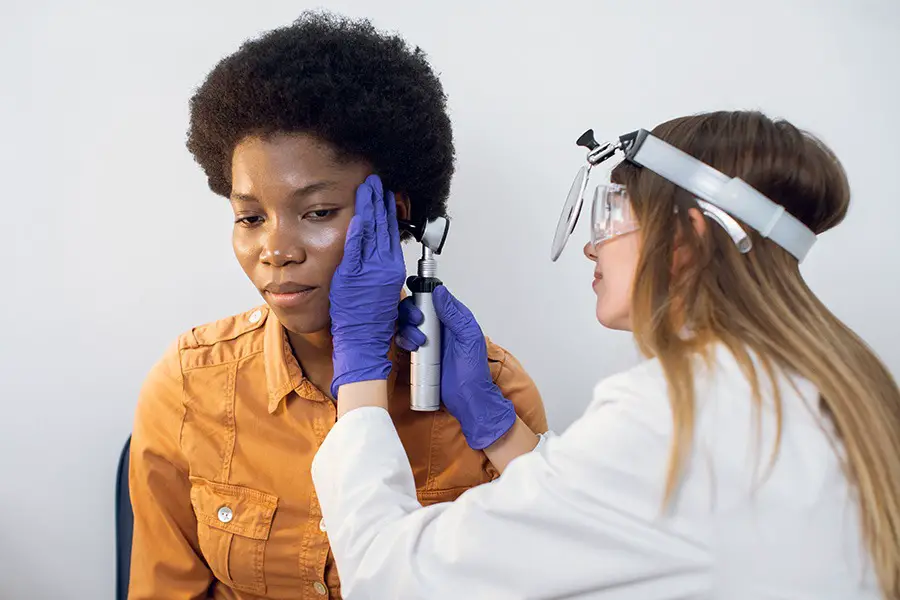Introduction
The intriguing world of audiology abounds with studies and advancements concerning sensorineural hearing loss (SNHL), one of the most widespread forms of hearing impairment. This type of hearing loss is primarily attributed to damage within the inner ear or the auditory nerve. Through technological and scientific progress, we have begun to comprehend, manage, and even avert SNHL more effectively. The following blog post delves into some of the groundbreaking research and technological breakthroughs that are reshaping our perception and handling of SNHL.
The core of our exploration encompasses gene therapy, a hopeful prospect in treating SNHL where traditional treatments have proven inadequate. Our journey also uncovers the exciting landscape of current clinical trials, shedding light on promising innovations for managing this challenging condition. We then delve into the consistent evolution of cochlear implants, a longstanding solution for SNHL, while also uncovering the preventive role of antioxidants. Lastly, we examine the captivating conjunction of nanotechnology and SNHL, a budding field that stirs curiosity and hope.
Each of these domains uncovers a peek into the future of SNHL treatment and prevention, instilling a renewed sense of hope in adults afflicted with this condition. Join us on this explorative journey, as we delve into the groundbreaking approaches to sensorineural hearing loss that are transforming the audiology field.
OTC Hearing Aid Pair
Experience the world like never before with the RCA OTC Behind-the-Ear Hearing Aid. Our advanced digital technology ensures that every sound is crystal clear and vibrant, allowing you to fully immerse yourself in life’s experiences. Whether it’s the laughter of loved ones or the music that moves you, our hearing aid brings back the joy of every moment.
Say goodbye to the hassle of appointments and prescriptions. The RCA OTC Hearing Aid is designed to meet the needs of individuals without the need for a prescription. With its seamless setup and user-friendly design, you can effortlessly enhance your hearing abilities and stay connected to the world around you. Simply unpack, wear, and enjoy improved auditory perception instantly.
Experience optimal comfort and style with our discreet behind-the-ear design. The thin tube design allows you to wear glasses comfortably, so you can enjoy clear hearing while maintaining your personal sense of style. Plus, our rechargeable battery ensures long-lasting power, eliminating the inconvenience of constantly replacing small batteries. Elevate your hearing experience with the RCA OTC Hearing Aid and embrace the world with confidence.
Gene Therapy in Treating Sensorineural Hearing Loss: The Latest Research
The promise of gene therapy as a potential turning point in treating sensorineural hearing loss has been acknowledged for years. Its objective is to rectify or replace defective genes responsible for hearing loss, thereby addressing the issue at its origin.
Recent progress in this domain has been particularly encouraging. For instance, a research study by Géléoc and peers exhibited the effective use of gene therapy in restoring hearing in a mouse model of human genetic deafness. While the leap from mice to humans is considerable, this study has ignited a wave of optimism that gene therapy could be a viable treatment for certain types of SNHL.
Moreover, advancements in CRISPR-Cas9 technology, a gene-editing tool, have ushered in fresh possibilities for treating SNHL. This groundbreaking technique permits precise editing of the genome, potentially enabling scientists to correct mutations that lead to sensorineural hearing loss. However, the intricacies of the human ear and the plethora of genes involved in hearing render the road to human trials challenging. Nonetheless, the potential of this approach keeps researchers and patients alike hopeful for what the future holds.
Current Clinical Trials: Innovations in Sensorineural Hearing Loss
There are currently a multitude of clinical trials globally focused on uncovering and developing innovative treatments for sensorineural hearing loss. These trials are investigating a wide range of strategies, from drug therapies to pioneering surgical procedures.
One such trial is scrutinizing the effectiveness of FX-322, a drug developed to stimulate the growth of sensory hair cells within the inner ear. Early findings propose that this drug may possess the potential to restore a certain level of hearing in individuals with SNHL.
Audion Therapeutics is conducting another trial using a similar method, employing a drug named LY3056480. This drug also aspires to regenerate sensory hair cells within the inner ear, an innovative approach for treating SNHL. Initial results have shown potential, with more extensive testing required to verify safety and efficacy.
These clinical trials exemplify the unyielding quest for innovative treatments for sensorineural hearing loss. With each successful trial, we inch closer towards more effective solutions for those grappling with this demanding condition.
Advancements in Cochlear Implants: An Ongoing Research
Cochlear implants have long been an established solution for individuals grappling with severe to profound sensorineural hearing loss. These inventive devices circumvent the damaged inner ear, dispatching electrical signals directly to the auditory nerve
. But the evolution of this technology does not stand still, with ongoing research persistently enhancing the functionality and user-friendliness of these life-altering devices.
One of the most remarkable advancements is the emergence of fully implantable cochlear implants. Unlike their traditional counterparts requiring an external sound processor, these fully implantable devices are entirely concealed under the skin. This not only offers cosmetic advantages but also eliminates many of the daily hassles associated with external components.
Furthermore, efforts to enhance sound quality and speech comprehension are continuous. For instance, initiatives to develop new processing strategies aim to amplify the clarity and naturalness of sound delivered by the implants. This includes algorithms that more precisely mimic the function of a healthy inner ear, potentially improving performance in noisy settings.
Though cochlear implants are not a cure for sensorineural hearing loss, these advancements significantly enhance the quality of life for those who depend on them. As research progresses, the future for cochlear implants looks brighter than ever.
QUIZ - CAUSES AND THE LEVELS OF TINNITUS
The Role of Antioxidants in Preventing Sensorineural Hearing Loss
The potential contribution of antioxidants in preventing sensorineural hearing loss is attracting increasing interest among the scientific community. The theory proposes that by neutralizing harmful free radicals within the body, antioxidants could potentially shield the fragile structures of the inner ear from damage.
Several studies have observed a correlation between increased intake of antioxidants and reduced incidences of hearing loss. For example, a study published in the Journal of Nutritional Biochemistry found that regular consumption of antioxidants like vitamin C, vitamin E, and beta-carotene was linked to a decreased risk of SNHL.
However, it’s crucial to remember that while antioxidants may contribute to preventing hearing loss, they are not a panacea. Sensorineural hearing loss can be triggered by various factors, including genetics and exposure to loud noise, which cannot be counteracted by antioxidants alone.
Nanotechnology and Sensorineural Hearing Loss: An Emerging Field of Study
Nanotechnology, the manipulation of matter at the atomic and molecular level, is an emerging field with potential applications in the treatment of sensorineural hearing loss.
One promising area of research is the utilization of nanoparticles for drug delivery to the inner ear. This approach could potentially bypass one of the greatest challenges in treating SNHL: delivering drugs past the body’s natural defenses and into the inner ear where they can take effect.
Another hopeful area of research involves using nanofibers to enhance cochlear implants. By making the implant electrode thinner and more flexible, it’s thought that nanofibers could reduce damage to the sensitive structures of the inner ear during implantation.
While nanotechnology’s role in treating sensorineural hearing loss is still nascent, the opportunities it offers are exhilarating. With ongoing research and development, nanotechnology may assume a pivotal role in the future of SNHL treatment.
Conclusion
The path to understanding and treating sensorineural hearing loss is intricate and demanding, yet it carries an aura of hope and optimism. From the promising strides in gene therapy, leveraging the potential of CRISPR-Cas9 technology, to the intriguing investigations centered around the role of antioxidants, our knowledge of SNHL is constantly broadening.
Global clinical trials are embracing innovative strides, investigating drug therapies like FX-322 and LY3056480 that may stimulate the growth of sensory hair cells, potentially revolutionizing the treatment of SNHL. The ongoing advancements in cochlear implants, notably the evolution of fully implantable devices, are improving the quality of life for many patients, rendering this technology more accessible and convenient than ever before.
The crossroads of nanotechnology and SNHL unveils exciting applications like nanoparticles for targeted drug delivery and nanofibers for improved cochlear implants. As research forges ahead, we can anticipate a shift from merely managing SNHL to possibly reversing or
even preventing it.
While the journey is still ongoing, these developments light the way forward for the millions of adults globally who are affected by sensorineural hearing loss. Through the collective endeavors of scientists, clinicians, and patients alike, the future of SNHL treatment looks promising, defined by innovation, empathy, and a steadfast dedication to improving the quality of life for those living with this condition.

Decoding Silence: An Analytical View on the Advances in Conductive Hearing Loss Research and Treatment
This analytical article sheds light on conductive hearing loss, offering an in-depth exploration of its genetic factors, treatment advances, and promising experimental therapies.

Embracing the Melody of Life: Navigating the Journey with Conductive Hearing Loss
A blog post delving into the experiences and challenges of living with conductive hearing loss, discussing its impact on everyday life, social interactions, mental health, and the potential benefits of hearing aids and cochlear implants.





